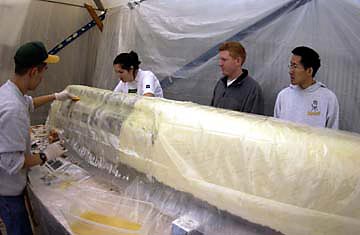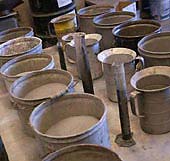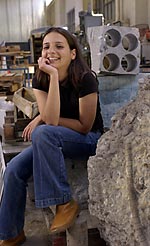 |
| Concrete
canoe team members (from left) Hank Fung, Lacey Walker,
Chris Conkle and John-Michael Wong work on a fiberglass
mold of the hull. Bart Nagel photos |
Concrete
canoe racers pin their hopes on ‘Calcatraz’
19 June 2002
By Diane Ainsworth, Public Affairs
Take
a little Portland cement (Type II only), add some low density
aggregates to obtain the correct water-cement ratio, mix and
apply to the fiberglass hull of a canoe, let cure for several
weeks and voila! A concrete canoe fit for competition.
 |
| After
designing the canoe's form, the team concocts and tests
more than 30 different concrete mixes to produce the perfect
light-but-strong result. |
Berkeley’s
recipe for the 130-pound canoe, affectionately called "Calcatraz,"
sets sail Monday, June 24, on Lake Mendota, next to the University
of Wisconsin-Madison campus, in the 14th annual National Concrete
Canoe Competition.
The campus’s entry — named after Alcatraz Island,
with the "C" added to meet tournament rules that "Cal"
be somewhere in the name — was designed by 14 undergraduate
civil and mechanical engineering students. They are competing
against 500 engineering students from 25 colleges nationwide
in a test of brains, not brawn.
The race is something of an oxymoron — how can a concrete
canoe float, let alone race? — but therein lies the challenge.
The competition isn’t designed to be an Olympic racing
event, but rather to encourage innovative thinking and to give
promising young students a venue to show off their engineering
prowess.
A splash of real-life learning
As
most Berkeley contestants, past and present, would agree, there’s
more to be learned when the paddles hit the water than can ever
be taught in the classroom.
 |
| Margarita
Constantinides, the concrete canoe team's project manager,
won this year's Civil Engineering Department Citation. She
will begin graduate school at Cal in the fall. |
"I’ve
learned more about canoes than I’ve ever learned from any
class," says Margarita Constantinides, Calcatraz project
manager, who received her bachelor of science degree in engineering
this spring. "You learn not only the technical details
of canoe construction, but to really pay attention to the small
details. You realize that theory doesn’t always turn out
to be right."
Calcatraz, a 21-foot-long, four-person canoe, is to arrive on
the UW-Madison campus by trailer on June 20, one day before
the start of a four-day national student conference marking
the American Society of Civil Engineers’ (ASCE) 150th anniversary.
The canoe competition, cosponsored by ASCE and Master Builders,
Inc., is one of three national engineering student contests
being held simultaneously at the same location, along with the
National Student Steel Bridge Competition and the National Daniel
W. Mead Contest on engineering ethics. The competitions are
expected to draw more than 1,500 engineering students, faculty,
alumni and friends from campuses all over the country. Berkeley
will compete in the National Concrete Canoe Competition beginning
at 8 a.m. June 24.
Seeking the perfect mix
Calcatraz
was hatched in the Concrete Lab in Davis Hall last August, when
the aspiring Berkeley engineering students first met to begin
brainstorming about canoe designs. They needed something lighter
and faster than "Magical," Berkeley’s 2000 canoe
entry, says Constantinides, so they broke up into smaller teams
and focused on design, construction and selection of materials.
"We
chose a special manmade aggregate that was low density and kind
of like glass bubbles to use in our cement," Constantinides
says. "The people responsible for the mixture came up with
about 25 or 30 concrete mixes by varying the quantities of each
mixture and the water-cement ratios. Then they had to test the
strength of each mixture, essentially by breaking the concrete
apart."
Other students concentrated on the hull design, reinforcements
that would allow the boat to withstand maximum stress, and construction
of the vessel.
"It
was tough and we had conflicting goals," Constantinides
says. The sprint races would require canoes that were long and
slender for maximum speed; the slaloms require shorter canoes
that can make tight turns around the buoys.
The solution was a shorter canoe.
"This
year, our canoe is shorter in length, 21 feet instead of 23
feet, has a narrow beam for high, straight-line speed, a flat-bottom
cross-section for improved initial stability, and a flared back
section to allow the back paddler to sit further back and increase
turning speed," Constantinides says.
Roots of concrete canoe racing
Concrete
canoe races date back to the late 1960s. Both the University
of Illinois-Urbana and UC Berkeley claim they held the first
ASCE regional competitions in the early 1970s. In 1988 the concrete
canoe race became a national competition, sponsored by ASCE
and Master Builders, Inc.
Berkeley students must raise the majority of funding for their
$20,000 canoes during the course of the school year. A modest
amount of funding is provided by the university’s College
of Engineering, but most of the money— about $12,000 to
$13,000, says Constantinides — is raised through contributions
from engineering and construction firms interested in publicity
during the national competition. Company logos are displayed
on the team’s T-shirts and canoe.
Berkeley usually performs well in the races, says Constantinides.
In fact, the campus has four national titles under its belt.
Last year, the team won first place in the regional competition,
but placed ninth in the nationals.
Nine industry professionals will judge this year’s competition.
Seventy percent of the total score for each team will be based
on written, oral and display presentations of canoe design,
construction and materials, as well as overall appearance and
structural integrity of the boats. The remaining 30 percent
of the score will be earned in a series of distance and sprint
races on Lake Mendota.
For more details:
|